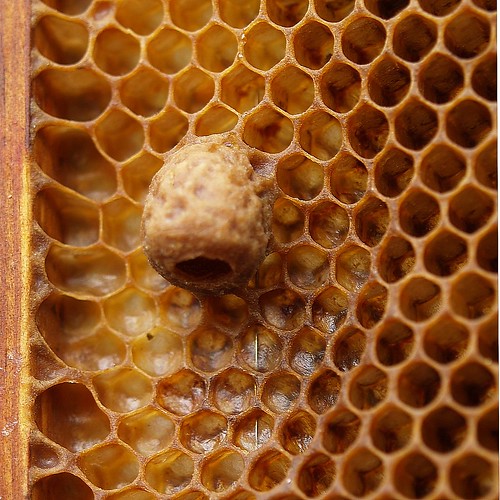It’s a new year, and a new American Honey Queen and
Princess have been chosen to represent the American Beekeeping Federation and
travel across the country speaking about honeybees and beekeeping. A panel of
judges makes the final decision, but have you ever wondered how a honeybee
colony gets a new queen bee?
In our world, a person might be elected or chosen to
become a queen, but in the world of the honeybee, a tiny egg is destined to
develop into a queen from nearly the first day of its life. The queen bee has
the very important job of laying all the eggs inside the hive. If a queen bee
is growing old or if she suddenly dies, the worker bees must make a new queen
in a hurry so there will be a queen in the hive to start laying eggs again.
To make a queen bee, workers select a few fertilized eggs
and they begin to expand the size of their cells. These special queen cells are
about the size and shape of peanut shells. The queen bee is the largest bee in
the hive, and she needs plenty of room to develop and grow. As the egg grows
into a larva, which looks like a fat, white worm, the worker bees start to feed
the young larvae a special substance called royal jelly, which is produced from
glands inside the workers’ mouths. Royal jelly is bee super food. It is very
rich in calories, vitamins, and proteins. Every honeybee larva, including
workers and drones, eats a small amount
of royal jelly during its development, but a larva that is going to be a queen
bee needs a lot of it every day of her life. As the larvae eat the royal jelly,
their bodies change and they develop into queen bees instead of regular worker
bees. After 16 days, a brand new queen emerges.
 |
| A queen larva inside her cell. Do you see the royal jelly? |
 |
| A queen cell is about the size and shape of a peanut shell. |
For beekeepers, the next step is to use a special marker
to paint a dot on the backs of new queens. They do this to make the queen
easier to find inside of the hive, but also to show how old each queen is. As
an industry standard, beekeepers around the world have a system, and they use 5
colors to mark their queen. Each color corresponds to a different year:
White
|
Years ending in
1 or 6
(Like 2011 or
2016)
|
Yellow
|
Years ending in
2 or 7
|
Red
|
Years ending in
3 or 8
|
Green
|
Years ending in
4 or 9
|
Blue
|
Years ending in
5 or 0
|
 |
| This queen is marked blue. What year was she born? |
Beekeepers will use a yellow dot to mark all queens produced
in 2012. What color would you be if you were a queen? Use the chart to find
out! For example, if you were born in 2003, you would be marked with a red dot.
